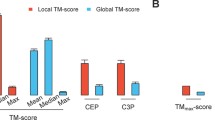Abstract.
The “hybrid protein model” is a fuzzy model for compacting local protein structures. It learns a nonredundant database encoded in a previously defined structural alphabet composed of 16 protein blocks (PBs). The hybrid protein is composed of a series of distributions of the probability of observing the PBs. The training is an iterative unsupervised process that for every fold to be learnt consists of looking for the most similar pattern present in the hybrid protein and modifying it slightly. Finally each position of the hybrid protein corresponds to a set of similar local structures. Superimposing those local structures yields an average root mean square of 3.14 Å. The significant amino acid characteristics related to the local structures are determined. The use of this model is illustrated by finding the most similar folds between two cytochromes P450.
Similar content being viewed by others
Author information
Authors and Affiliations
Additional information
Received: 13 June 2000 / Accepted: 18 September 2000 / Published online: 19 January 2001
Rights and permissions
About this article
Cite this article
de Brevern, A., Hazout, S. Compacting local protein folds with a “hybrid protein model”. Theor Chem Acc 106, 36–47 (2001). https://doi.org/10.1007/s002140000227
Issue Date:
DOI: https://doi.org/10.1007/s002140000227




